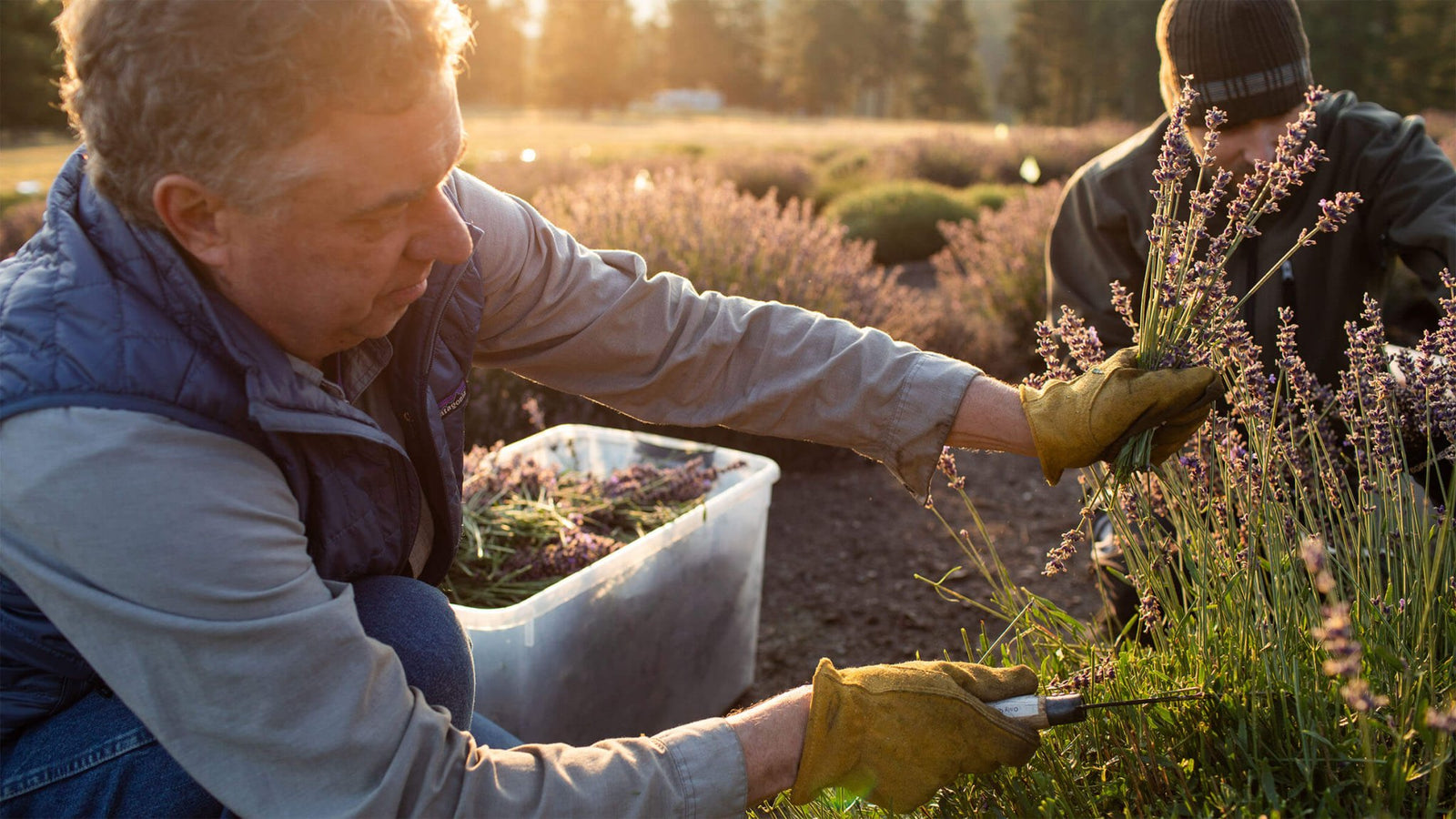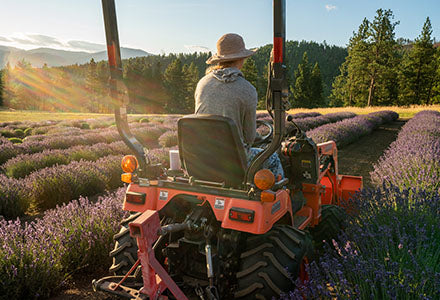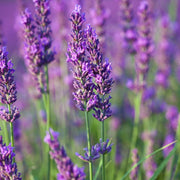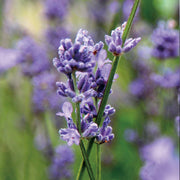Cultivating high-altitude, artisan lavender products

Cultivating high-altitude, artisan lavender products
Growing multiple varieties of our own lavender high in the Rocky Mountains allows us to tailor some of the most exquisite, aromatically beautiful, and therapeutically potent lavender essential oil and hydrosol in the world.
We’re with our lavender plants from the time they’re seedlings, hand-watering and weeding them on a daily basis. When harvest season rolls around, we hand-harvest the lavender with special, serrated sickles, and mindfully distill each batch.
What is high-altitude, artisan lavender?


Lavender (Lavandula angustifolia) is one of the most popular aromatherapy products in the world—and for good reason! Lavender essential oil is incredibly gentle and versatile, with deeply restoring effects for the body, heart, and mind.
Lavender thrives best at high altitudes, where the elevation helps to increase the content of its most therapeutic components, such as linalyl acetate—an ester that’s been proven to have nourishing effects for skin, and a calming influence on the nerves.
At Aromatics, we cultivate 12 varieties of lavender. When their essential oils are distilled, we carefully blend them together to craft a unique artisanal product.
Aromatics’ certified organic, artisan lavender oil and hydrosol
The environment around our warehouse and offices is ideal for lavender cultivation.
We’re located at 4,700 feet above sea level, and the hillsides are inclined just enough to keep the soil well drained.
Our farmer Larry Williams has traveled the globe and witnessed a variety of growing conditions. In some places, plants are grown in close proximity to cities or roads, where the air quality isn’t very pure. Other farms have soil that isn’t well drained. And some plants are grown too close to fields treated with pesticides and sprays with no guarantee that the harmful chemicals won’t seep over into the untreated land.
When Larry and Karen saw the immaculate environment of Aromatics’ land in the Montana mountains, they knew right away it offered the perfect conditions for growing lavender.
As Larry said...
“The purity of our Montana environment can’t be overstated. There is no air pollution. The soil is so pure and rich, you could eat it.”
There are over 45 varieties of Lavandula angustifolia. At Aromatics, we cultivate 12 of the most beautiful, sweet-smelling, therapeutic varieties, including Buena Vista and Royal Velvet.
We distill each of our lavender varieties individually in traditional copper stills.
When visitors come to our farm to see our lavender, they can smell the difference between our 12 varieties of lavender essential oil. Some are more floral, some more herbal. Some have a distinct honey aroma, while others have rich notes of caramel.
Blending each of these varieties together allows our Certified Aromatherapists to craft a truly exquisite artisan lavender essential oil, tailoring the final product for the most beautiful, unique scent, and the richest concentration of therapeutic components.
Our lavender hydrosol receives the same special treatment, carefully blended for an artisanal floral water you won’t find anywhere else in the world.
A note about copper stills


At Aromatics, using copper stills is another way we put our value of quality over quantity into practice.
Stainless steel stills are popular among bigger operations, because stainless steel can produce a large amount of essential oil in a short amount of time.
However, essential oils distilled in stainless steel need time to “cure” before they smell beautiful. For example, it can take from four to six weeks before a batch of lavender essential oil distilled in stainless steel smells sweet and floral.
Copper stills produce less essential oil, but skip the “curing” stage. The essential oils smell sweet immediately after distillation. This means they can be packaged and sold more quickly, resulting in fresher oils with longer shelf lives.
What is a hydrosol?
A hydrosol is the water-based portion of a plant’s distillation.
When an aromatic plant is steam-distilled, it is exposed to both heat and moisture. The heat allows the plant to release its essential oil, while the moisture from the steam captures the plant’s water-soluble elements, transforming water into therapeutic hydrosol.
Hydrosols are gentler and less concentrated than essential oils, but no less effective when used properly. While most essential oils should be diluted before topical use to ensure safety, most hydrosols can be applied directly to skin.
Many distillers treat hydrosols as a by-product (or simply throw the hydrosol away). However, treating hydrosol as a by-product can compromise its quality.
Obtaining the most therapeutic and aromatically stunning hydrosol demands a longer process, requiring more time than it typically takes to distill essential oils. For some distillers, creating high-quality hydrosols isn’t economically possible. (They’re focused only on creating as much essential oil as they can.)
We distill our lavender specifically for the hydrosol, starting with pristine well water from our land in the Rocky Mountains. A single distillation session can last around four hours. We test the pH of our hydrosol every half hour to track its quality. Toward the end of the session we test every fifteen minutes, stopping the distillation as soon as the hydrosol has passed its ideal pH levels.
Our process takes time, but the result is worth it.
Benefits and uses of high-altitude, artisan lavender products

Lavender essential oil is rich in the natural components linalool and linalyl acetate.
These two constituents have been widely studied, and proven to have a wide variety of benefits.
Thanks to this research, we know that lavender oil is perfect for helping to restore damaged skin to full health and integrity. Use it in rejuvenating skin care blends such as lotions and moisturizers. It’s also strong enough to offer support in more urgent situations, such as for bruising, an achy head, tight muscles, and during cold and allergy seasons.
And of course, our lavender artisan essential oil lives up to lavender’s famous reputation for relaxation! Calm down with a few drops in your diffuser before bedtime, or add it to a roll-on blend to stay emotionally balanced throughout the day.
Our lavender artisan hydrosol has similar emotional benefits to the essential oil. A few sprays of hydrosol can help you feel peaceful and balanced. It’s especially lovely as a linen spray before bed!
You can also add lavender hydrosol to your skin care routine. Use it alone as a toner to quiet redness and help repair skin’s texture, or combine it with other products to customize blends that are perfect for your skin’s unique needs.
Lavender hydrosol is right at home in your blends for natural cleaning, too. Freshen your indoor air with it, or spray it on your upholstery and carpets.
Lavender artisan recipes
Learn more about lavender!
Lavender is truly timeless! This gorgeous shrub is a member of the mint family, with long spikes of purple flowers. It has been used since ancient times, and its popularity is still going strong.
Originally found in the Mediterranean region, lavender is now cultivated all over the world.
Growing our own lavender is full of challenges and rewards!
The first spring and summer of developing our new lavender farm brought our family together.
We drove to Oregon to fill a horse trailer with hundreds of tiny, organic, lavender plants, purchased from a friend who values sustainability as much as we do. Then we prepared our field by asking for Mother Nature’s blessing on our new project as we, plowed the rich, dark, chocolatey earth.
We made circles in the dirt and spent hours planting. Young lavender plants require a lot of water, and we took turns watering them by hand every day.
Cultivating high-altitude, artisan lavender products
Shop this Guide
Join Our Newsletter
Save 15% on your first order
Aromatherapy sent directly to your inbox. Receive tips, essential oil recipes, promotion alerts, live events and more. We look forward to connecting with you! *Exclusions apply.




